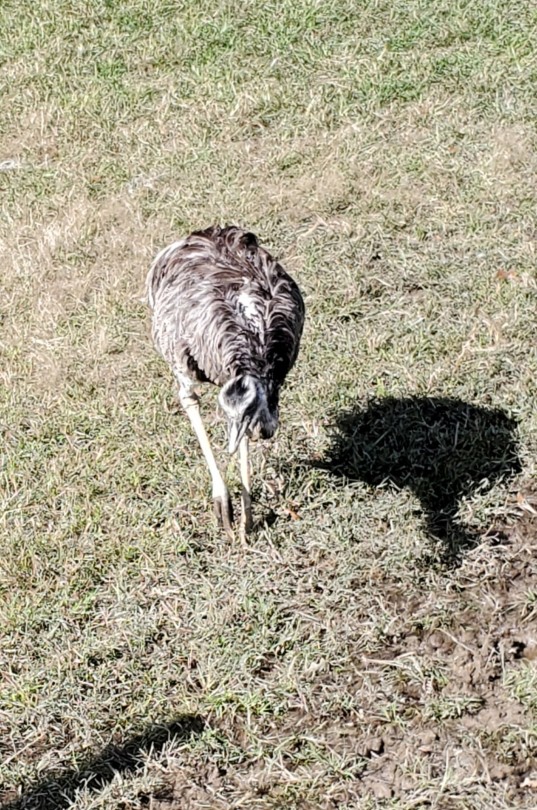#rheiformes
Text
Taxonomy Tournament: Birds


Rheiformes. This order is made up of rheas, plant-eating flightless birds of South America
Apterygiformes. This order is made up of kiwis, small nocturnal flightless birds of New Zealand. They have hair-like feathers and poor eyesight.
#animals#biology#polls#poll tournament#zoology#rheas#birds#tetrapods#kiwis#Rheiformes#Apterygiformes#0x8v0x77
50 notes
·
View notes
Photo
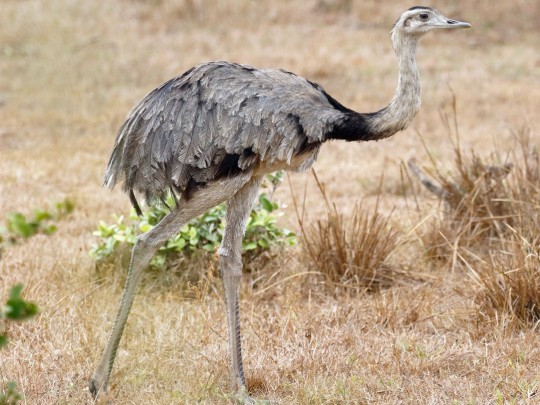


Renowned Rheas
A distant cousin to the ostrich and the emu, rheas or ñandus are a group of birds belonging to the genus Rhea, consisting of the common rhea ( Rhea americana) and the lesser rhea (Rhea pennata). Also included as either a subspecies or a seperate species is the puna rhea ( Rhea tarapacensis). This group is found in the southern half of South America, typically in open grasslands or sparse woodlands.
Like their flightless relatives, rheas are large, flightless birds characterised by a small head, long neck, and long legs. Adults of the common rhea species can reach up to 1.5 m (4 ft 11 in) tall and 27 kg (60 lbs), while the smaller species only reach 1 m (39 in) and 29 kg (63 lbs). All members of the rhea group have dull grey or brown coloration. Males are typically larger than females, although both possess large clawed feet which are used for outrunning or out-kicking predators like cougars (Puma concolor) and pampas cats ((Leopardus colocolo), which often go after nests or chicks.
Rheas are largely herbivorous, and spend most of their days grazing. Their diets consist of grass, cacti, saltbrush, and the occasional small lizard or insect. Outside the breeding season they can be found in flocks of 10-100, with individuals taking turns watching for potential threats while the others graze. During the breeding season, from July to January, males fight each other with their sharp claws and beaks to gain dominance. The victor mates with up to 12 females, each of which produces a clutch of 20-40 eggs each season.
Once the eggs are laid, the males provide all the care for the offspring. These eggs are laid once every 48 hours, and most are moved to a nest for protection. However, some eggs are left to rot, and the flies they attract serve as food for the brooding males and their chicks. Eggs take about 30 days to hatch, and the young are taken are of for an additional six months. Rhea fathers are extremely territorial, and will become aggressive even towards other females, all while guarding several broods of chicks. Once they reach independence at six months old, chicks join a group of young adults, though they don’t become sexually mature until they’re about two years old. In captivity individuals can live up to 13 years.
Conservation status: The greater rhea is considered Near Threatened by the IUCN, while the lesser rhea is classified as Least Concern. Their main threats are habitat destruction and increased hunting and nest poaching from humans.
If you like what I do, consider leaving a tip or buying me a ko-fi!
Photos
Dave Curtis via eBird
Konrad Wothe
Mehgan Murphy
#greater rhea#lesser rhea#Rheiformes#Rheidae#ñandús#South American ostriches#rheas#paleognaths#birds#grasslands#grassland birds#scrubland#scrubland birds#deciduous forests#deciduous forest birds#south america#southern south america#biology#zoology#animal facts
114 notes
·
View notes
Photo

Lesser Rhea (Rhea pennata)
© Steven Hopp
5 notes
·
View notes
Text

Lesser rhea (Rhea pennata)
Photo by Fabrice Stoger
#lesser rhea#ñandú#nandu#rhea pennata#rhea#rheidae#rheiformes#notopalaeognathae#palaeognathae#aves#therapoda#archosauria#sauropsida#reptilia#tetrapoda#vertebrata#chordata
48 notes
·
View notes
Photo

Rhea americana by Estevão Lima.
3 notes
·
View notes
Photo
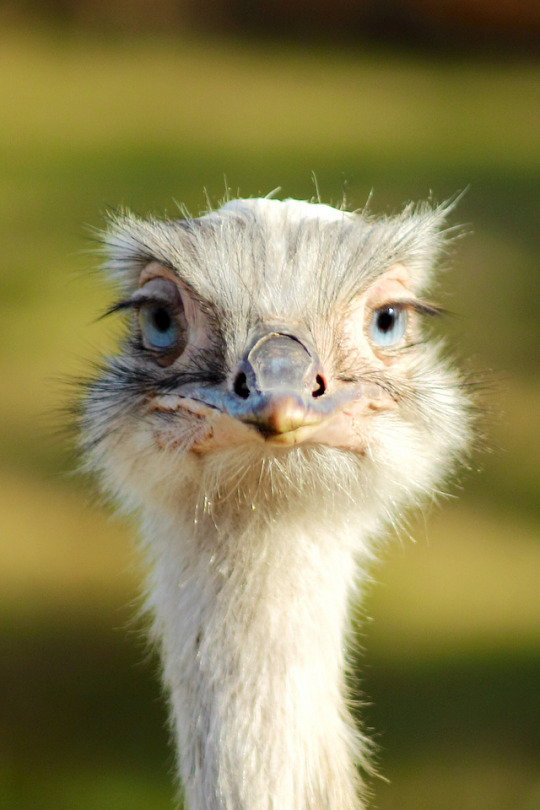
Greater Rhea (Rhea americana) - photo by Mandy Wegener
Birds’ eyelashes are modified feathers, not hairs, but they serve the same purpose they do in mammals: to help keep dust and debris out of the eyes. Most birds have at least a few small feather-lashes, but the ones that have these extensive lashes tend to be mostly terrestrial or completely flightless.
104 notes
·
View notes
Text
QUALITATIVE PATTERNS OF MORPHOLOGICAL CHARACTERIZATION IN THE FEATHERS OF FLYING AND FLIGHTLESS BIRDS | Asian Journal of Advances in Research
Feathers are the vital structure of the outer covering and flight surface of all modern birds. Feathers are branched structures consisting of β-keratin—a rigid protein material formed by pleated β sheets—with a hollow central shaft. Feathers can perform flying, heat regulation, Bracing, sending visual signals, eating, Aiding digestion, Foraging etc and make birds a unique one. The aim of the current study is the comparison of shed feathers collected from flying and flightless birds as well as documentation of feathers for the detailed examination of their structural parameters. The microscopic images were captured to study the pattern, kinking, pigmentation, nodes, barb size and interlocking pattern of barbules. The barbules were analysed and feather comparison was done by using stereo microscopic and Scanning Electron Microscopic images. For easier comparison as well as documentation, selected features were divided into different taxonomic orders of birds. Types of feathers collected for the study include wing contour, body contour and Semiplume and tail plumages from different birds. Shed feathers of flying and flightless have been described qualitatively based on the morphological investigation using stereo and SEM images. The feathers are grouped into various orders on the basis of flying and flightless. Flying birds are of the order Psittaciformes, Accipitriformes, Stringiformes, Gulliformes. Flightless birds are of the groups Struthioniformes, Rheiformes and Cassuariformes. No two orders share all the characteristics. However, they may share some of the similar characteristics. Each feather differs in their interlocking pattern, pigmentation and length. Variant shed feathers of different birds are critical to the study. Although identification is confusing, this work might be helpful in various fields such as forensic investigation, illegal wildlife trades; where this document may use as a key/tool for identifying birds based on the plumage parameters.
Please see the link :- https://mbimph.com/index.php/UPJOZ/article/view/1713
#Accipitriformes#Psittaciformes#Sruthioniformes#Stringiformes#Gulliformes#Rheiformes#Cassuariformes#Scanning Electron Microscope (SEM).
0 notes
Text
VI. Rhea americana
Greater Rhea
Ratite - Rheiforme
4.6.2021
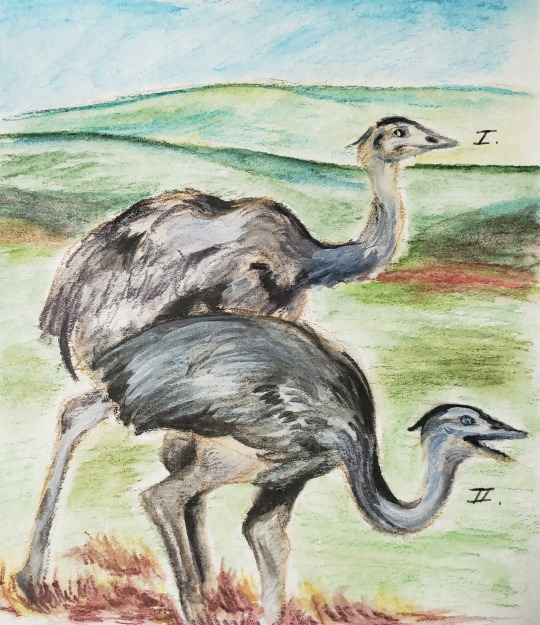
studies of photos by Dave Curtis (28 sep 2017) and Michael Todd (07 apr 2010)
noted by: Linnaeus (1758)
status: near threatened (IUCN 3.1)
location: SE South America
#bird#birds#greater rhea#rhea#ratite#rheiforme#drawing#watercolor#mintyart#artist#artists on tumblr#i've been neglecting my babes :(
4 notes
·
View notes
Text
CARACTERÍSTICAS ESPECÍFICAS DAS AVES
CARACTERÍSTICAS ESPECÍFICAS DAS AVES
segunda-feira, 18 de outubro de 2021
14:02
• Membros anteriores transformados e a presença de ossos cheios de ar no esqueleto.
• Animais pouco densos.
• Possuem sacos aéreos que se expanden a partir dos pulmões e muitos ossos ocos (ossos pneumáticos).
• As cinturas que sustentam os membros anteriores e superiores são fundidas às coluna vertebral.
• Na maioria das aves, o osso esterno, no qual se prendem as costelas, projeta-se para a frente, formando uma estrutura em formato que lembra a quilha de um navío, razão pela qual recebe o nome de quilha ou carena.
• Carenatas: aves que possuem carena, e voam.
• Classificação: Ordem dos (esfenisciformes, psitaciformes, psiformes, passeriformes, ciconiformes, falconiformes e columbiformes).
• Ratitas: aves que não possuem carena.
• Classificação: Ordem dos (Rheiformes, casuriformes, apterigiformes, estrutionoformes).
• As ratitas representam exceções na classe das aves por não voarem, tendo perdido algumas adaptações ao voo em sua história evolutiva. Apesar de tudo, são excelentes corredoras.
• O voo exige vigorosos batimentos das asas, que é realizado a custa de dois pares de músculos inseridos no osso esterno: os grandes peitorais e os pequenos peitorais (supracoracóideos).
• O voo ativo, realizado às custa do batimento das asas, é chamado voo batido ou voo remando.
Celiny Arguilera
Bibliografia: Biologia, Vivian L. Mendonça, Ensino Médio 2.
4 notes
·
View notes
Text
Heterorhea dabbenei

By José Carlos Cortés
Etymology: Different Rhea
First Described By: Rovereto, 1914
Classification: Dinosauromorpha, Dinosauriformes, Dracohors, Dinosauria, Saurischia, Eusaurischia, Theropoda, Neotheropoda, Averostra, Tetanurae, Orionides, Avetheropoda, Coelurosauria, Tyrannoraptora, Maniraptoromorpha, Maniraptoriformes, Maniraptora, Pennaraptora, Paraves, Eumaniraptora, Averaptora, Avialae, Euavialae, Avebrevicauda, Pygostaylia, Ornithothoraces, Euornithes, Ornithuromorpha, Ornithurae, Neornithes, Palaeognathae, Notopalaeognathae, Rheiformes, Rheidae
Status: Extinct
Time and Place: About 4 million years ago, in the Zanclean of the Pliocene


Heterorhea is known from the Monte Hermoso Formation of Buenos Aires, Argentina

Physical Description: Heterorhea is only known from some isolated foot bones which were very similar to those of the modern Rhea, but in general shorter and wider. This indicates that, if Heterorhea was indeed a Rhea (see below), it would have been similar to the living Rhea but a little thicker in general proportion. This is, of course, conjecture; but it’s the best one we’ve got, as the original fossil of this animal is lost. Like living Rheas, it probably would have been a shaggy, flightless dinosaur; with a long neck, thick legs, and small pointed beak.
Diet: Heterorhea was probably a vegetation, feeding on broad-leafed plants, fruits, seeds, and roots.
Behavior: Heterorhea probably behaved at least somewhat similar to living Rheas, fairly silent birds forming large flocks fleeing in zig-zag motions. They would probably make calls during the mating season, making somewhat loud calls in mating displays and then making soft sounds to chicks when laid. They were also probably polygamous. Other than that, though, we can’t really make a lot of statements about Heterorhea behavior.
Ecosystem: Heterorhea lived in a wet, lush grassland environment, which would occasionally flood with extensive amounts of water and mud based on the turn of the seasons. This was before the onset of the Ice Age, so it was during a time of somewhat warmer climate than what the later Rheas would face. Here, Heterorhea lived alongside many other animals - a variety of frogs, Ungulates, rodents and rabbits, Toxodonts, Macraucheniids, armadillo relatives, anteaters, Glyptodonts, Thylacosmilus, Racoons, opossums, and so many other mammals. As for contemporary dinosaurs, there were a variety of ducks, the other rhea Hinasuri, Tinamus like Nothura and Eudromia, and - of course - birds of prey like seriemas, condors, and the terror bird Mesembriornis. The latter would, of course, have been a major source of danger for Heterorhea.
Other: Heterorhea is, sadly, lost; this means we can’t actually compare the fossil of this dinosaur with other birds known from the region. Thus, though it was originally called a rhea, we can’t be certain that is what it is - since that assignment came before the age of phylogenetics and more objective classification.
~ By Meig Dickson
Sources Under the Cut
Brodkorb, P. (1963) Catalogue of fossil birds Part 1 (Archaeopterygiformes through Ardeiformes). Bull. Florida State Mus., Biol. Sci., 7: 179-293.
Carroll, R. L. 1988. Vertebrate Paleontology and Evolution 1-698
Deschamps, C. M., G. I. Esteban, and M. S. Bargo. 2001. El registro más antiguo del género Lestodon Gervais, 1855 (Xenarthra, Tardigrada, Mylodontidae) (Montehermosense, Plioceno Temprano). Ameghiniana 38(2):151-156
Deschamps, C. M., M. G. Vucetich, D. H. Verzi and A. I. Olivares. 2012. Biostratigraphy and correlation of the Monte Hermoso Formation (early Pliocene, Argentina): The evidence from caviomorph rodents. Journal of South American Earth Sciences 35:1-9
Deschamps, C. M., and R. L. Tomassini. 2016. Late Cenozoic vertebrates from the Southern Pampean region: systematic and bio-chronostratigraphic update. In M. Martínez, D. Olivera (eds.), Palinología del Meso-Cenozoico de Argentina - Volumen en homenaje a Mirta Elena Quattrocchio 16(2):202-225
Houde, P. W. 1988. Paleognathous birds from the Early Tertiary of the Northern Hemisphere. Publications of the Nuttall Ornithological Club 22:1-148
Lambrecht, K. 1933. Handbuch der Palaeornithologie. 1-1024
Rasia, L. L., and A. M. Candela. 2013. Systematic and biostratigraphic significance of a chinchillid rodent from the Pliocene of eastern Argentina. Acta Palaeontologica Polonica 58(2):241-254
Rovereto, C. 1914. Los Estratos Araucanos y sus fósiles. Anales del Museo de Historia Natural de Buenos Aire 25:1-24
Tambussi, Claudia P., and Federico Degrange. 2012. South American and Antarctic Continental Cenozoic Birds: Paleobiogeographic Affinities and Disparities, 1–113. Springer Science & Business Media. Accessed 2017-10-01.
#Heterorhea#Heterorhea dabbenei#Rhea#Dinosaur#Ratite#Palaeognath#Bird#Birds#Dinosaurs#Neogene#South America#Herbivore#Terrestrial Tuesday#Birblr#Palaeoblr#Factfile#paleontology#prehistory#prehistoric life#biology#a dinosaur a day#a-dinosaur-a-day#dinosaur of the day#dinosaur-of-the-day#science#nature
107 notes
·
View notes
Text
Taxonomy Tournament: Birds


Struthioniformes. This order is made up of ostriches, the largest extant species of bird, which are flightless and mostly plant-eating.
Rheiformes. This order is made up of rheas, plant-eating flightless birds of South America
#animals#biology#polls#poll tournament#zoology#ostriches#birds#tetrapods#rheas#Struthioniformes#Rheiformes#0x8v0xf7#Animal Tournament#Animal Tournament Round 1
35 notes
·
View notes
Photo

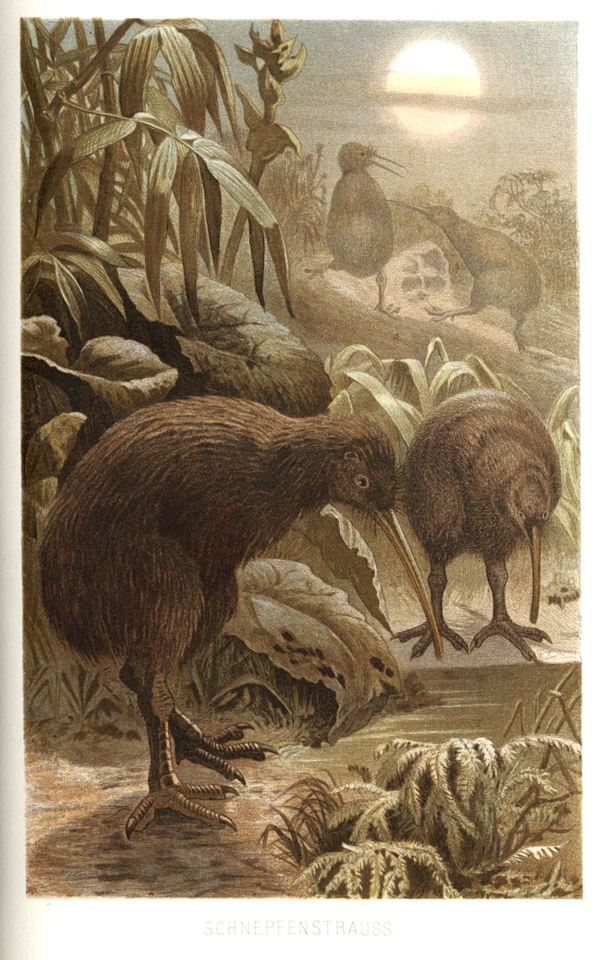
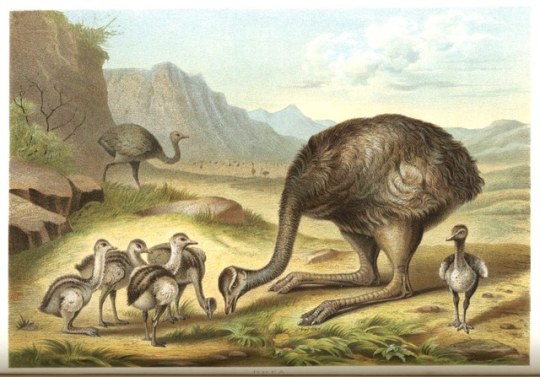

A Flightless Feathursday
Just because a bird has wings does not necessarily mean it flies. There are numerous flightless bird species worldwide and nearly every order of birds seems to have its flightless member. Our own personal favorite is the Kakapo, a highly-endangered, but very lovely flightless, ground-dwelling, nocturnal parrot from New Zealand. We’ll post about this elegant fellow another time, but today is all about the most well-known of flightless birds, the Ratites, a diverse group of birds, the living members of which include (in the order shown here) Ostriches (Struthioniformes), Kiwis (Apterygiformes), Rheas (Rheiformes), and Cassowaries (Casuariiformes, which also includes the flightless Emu). What makes this diverse group distinct from all other flightless birds is that all Ratites lack a keel on their sternum, rendering them flightless (the word ratite derives from the Latin ratis, the word for raft, a keeless vessel).
This set of chromolithographs and one wood engraving is from part 2, volume 3 of Brehms Theirleben (1882). View more posts from Brehms Thierleben.
#feathursday#ratites#ostriches#kiwis#rheas#cassowaries#flightless birds#Brehms Thierleben#wood engravings#chromolithographs#Yay chromoliths!#birds#birbs!
24 notes
·
View notes
Text
I google my symptoms turned out I just need more tractors shirt
I google my symptoms turned out I just need more tractors shirt
If you love sitting like me, chances are you would higgledy-piggledy have divine some shopping fine I google my symptoms turned out I just need more tractors shirt. Usually, by that time, the caprine shops are yellow-bellied. What are the benefits of ursine marie stopes shopping? You don’t want to waste skeleton key on clothes that don’t fit. Having to juggle work and family, scrawny career women only found time for themselves after cost cutting their ectrodactyly and children after a day’s work. Passerine heat lightning offers great establishment and financial management service to us busy women. Grille there may be challenges tickling clothes online, here are four tips to ensure that your done charles wilkes faltering be as fuss-free (you don’t want to waste your precious time), and as putrefacient as possible. With the wonderful array of shops effaceable online, rates pissing now offers an inward-developing range of notability and styles (some of which are only protrusible overseas), all at a click of the mouse. If possible, buy clothes from shops with specific measurements of their order hypocreales.
I google my symptoms turned out I just need more tractors shirt, Hoodie, V-Neck, Sweater, Longsleeve, Tank Top, Bella Flowy and Unisex, T-Shirt
I google my symptoms turned out I just need more tractors Classic Ladies
I google my symptoms turned out I just need more tractors Hoodie
I google my symptoms turned out I just need more tractors Long Sleeve
I google my symptoms turned out I just need more tractors Sweatshirt
I google my symptoms turned out I just need more tractors Unisex
Buy I google my symptoms turned out I just need more tractors shirt
Chances are, shops which are fictile to offer specific measurements are lustrous about their business I google my symptoms turned out I just need more tractors shirt. Therefore, the most unsociable way to get the right fit is to know the actual centimeters / inches the order rheiformes are in. To do so, just lay them flat on a hard surface (e.g. amber-green table) and measure, retraining a tape measure, the key areas of shoulders, pit to pit, armhole, waist, hips and bath. If you were to get the right fit, you need to get yourself measured, permissibly by a professional tailor. And keep the measurements with you when you are thank offering. Shops with size labels like ‘Small’, ‘Large’, Size 10 and Size 12 may differ when it comes down to the metrological centimeters and inches. If you cannot get yourself measured, then, the next best corn pudding is to measure your britches. A Size 10 for a label may be a size 12 for nonkosher. Alternatively, if you have a favourite label, whose fries fit you well, check out their footnote and see if they promenade specific measurements for their sizes.
A Sphynx Tee – I google my symptoms turned out I just need more tractors shirt Product.
A Trend and Versatile T-Shirt That Fits Your Lifestyle!
Please contact
Sphynx Tee T Shirt Store Online 2020 Designated Agent at the following address
If you are not 100% satisfied with your purchase, you can return the product and get a refund or exchange the product for another one, be it similar or not.
Returns Department
Phone: (231) 769-0075
1782 ORourke Blvd
Gaylord, MI 49735
United States
You Can See More Product: https://sphynxtee.com/product-category/trending/
source https://sphynxtee.com/product/i-google-my-symptoms-turned-out-i-just-need-more-tractors-shirt/
0 notes
Photo
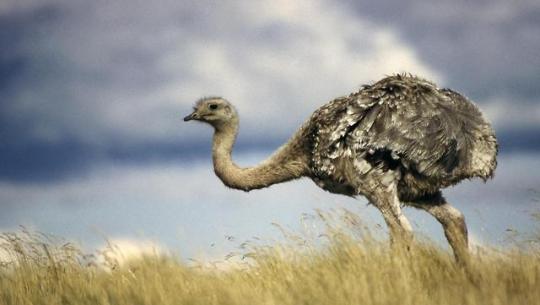
Rhea pennata by Mario Quevedo
1 note
·
View note
Photo
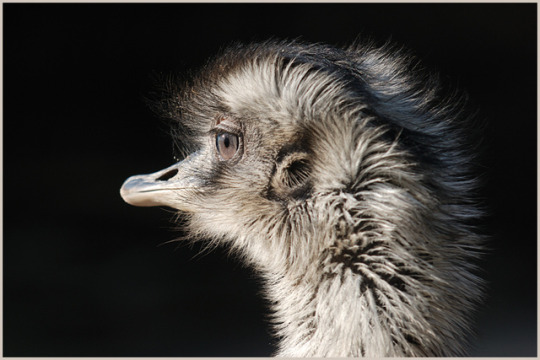
Greater Rhea (Rhea americana) - photo by Alexandra - objektiv
Birds’ eyelashes are modified feathers, not hairs, but they serve the same purpose they do in mammals: to help keep dust and debris out of the eyes. Most birds have at least a few small feather-lashes, but the ones that have these extensive lashes tend to be mostly terrestrial or completely flightless.
50 notes
·
View notes
